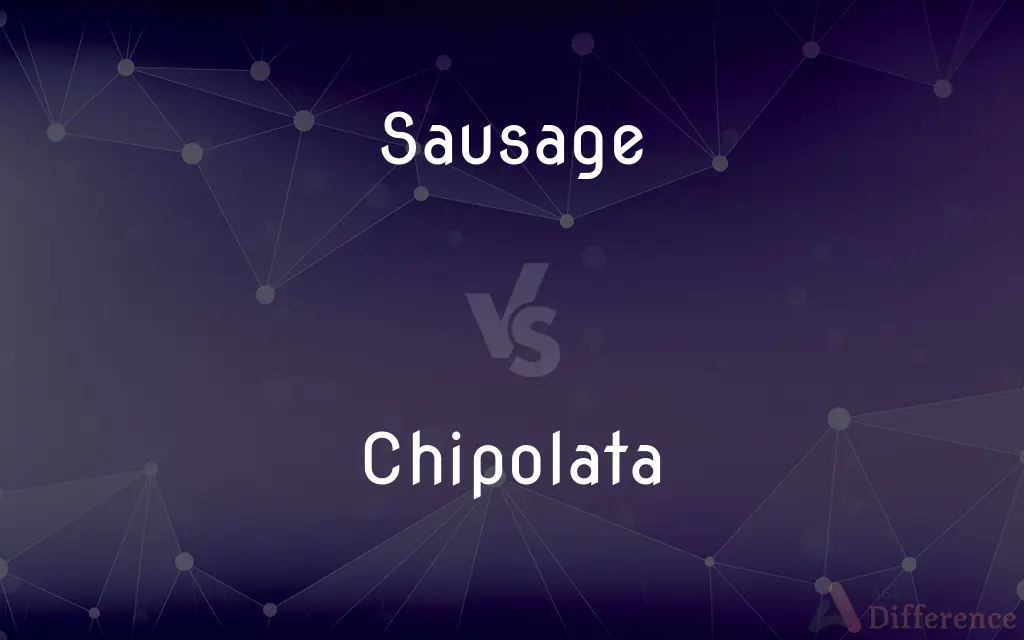Sausage vs. Chipolata — What's the Difference?
By Tayyaba Rehman — Updated on April 19, 2024
A "sausage" is a general term for meat encased in a skin, while "chipolata" is a specific, thinner type of sausage.

Difference Between Sausage and Chipolata
Table of Contents
ADVERTISEMENT
Key Differences
"Sausage" is a broad term encompassing a wide range of ground or minced meat products encased in a skin or casing. This casing can be made from a variety of materials, from natural intestines to synthetic alternatives. On the other hand, a "chipolata" is a specific type of sausage, generally thinner and smaller than many other sausages. It is especially popular in countries like the UK, France, and Italy.
Sausages can be fresh, cooked, dried, or smoked, and they can contain beef, pork, chicken, or even vegetarian ingredients. They are a staple in many cuisines worldwide, with countless regional variations, from German bratwurst to Chinese lap cheong. The term "chipolata" is believed to have Italian roots, derived from "cipolla," the Italian word for onion, suggesting an original flavor profile. However, the modern chipolata is not onion-flavored but is instead characterized by a mix of pork (and sometimes other meats) and various herbs and spices.
While a sausage can vary widely in size, flavor, and ingredients depending on the region or recipe, a chipolata has a more standardized size, usually being about the thickness of a finger. Their smaller size makes them ideal for certain dishes, grilling, or as an accompaniment to traditional holiday meals in some cultures.
In conclusion, while all chipolatas are sausages, not all sausages are chipolatas. It's essential to understand the distinction when shopping or cooking, as a sausage could refer to any number of meat products, but a chipolata denotes a specific, slender type of sausage.
Comparison Chart
Definition
A meat product in a casing.
A thin type of sausage.
ADVERTISEMENT
Size
Varies; can be thick or thin.
Typically slender, finger-sized.
Origin of Term
General term with Old Norse roots.
Likely derived from Italian "cipolla" (onion).
Varieties
Many types based on region and ingredients.
More standardized in size and flavor.
Usage
Universal, found in many cuisines.
Popular in UK, France, and Italy.
Compare with Definitions
Sausage
A meat product, often ground, encased in skin.
She grilled the sausage until it was golden brown.
Chipolata
A finger-sized sausage, ideal for grilling.
The chipolatas cooked quickly due to their thin size.
Sausage
A cylindrical meat product, often requiring cooking.
He bought a variety of sausages for the weekend barbecue.
Chipolata
A thin, small sausage.
She served the chipolata with mashed potatoes.
Sausage
Minced meat mixed with spices and often fillers.
The sausage had a spicy kick, thanks to the added paprika.
Chipolata
A flavorful small sausage, often with herbs.
The rosemary in the chipolata gave it a delightful aroma.
Sausage
Meat, often combined with fat, in a tubular shape.
The breakfast sausage complemented the eggs perfectly.
Chipolata
A slender meat product, typically pork-based.
The grilled chipolatas were the highlight of the meal.
Sausage
A blend of flavors encased, suitable for frying or grilling.
The sausage links were a hit at the family picnic.
Chipolata
A specific sausage type, often used in holiday dishes.
The Christmas turkey was served with stuffing and chipolata.
Sausage
A sausage is a type of meat product usually made from ground meat, often pork, beef, or poultry, along with salt, spices and other flavourings. Other ingredients such as grains or breadcrumbs may be included as fillers or extenders.
Chipolata
A chipolata () is a type of fresh sausage, likely created in France. Sausages by that name appear in the 1903 edition of Escoffier's Le guide culinaire.
Sausage
An item of food in the form of a cylindrical length of minced pork or other meat encased in a skin, typically sold raw to be grilled or fried before eating.
Chipolata
A small thin sausage.
Sausage
Used as an affectionate form of address, especially to a child
‘Silly sausage,’ he teased
Chipolata
A type of sausage from Europe, typically of seasoned coarsely ground pork.
Sausage
Finely chopped and seasoned meat, especially pork, usually stuffed into a prepared animal intestine or other casing and cooked or cured.
Chipolata
A small thin sausage
Sausage
A small cylinder-shaped serving of this meat.
Sausage
A food made of ground meat (or meat substitute) and seasoning, packed in a section of the animal's intestine, or in a similarly cylindrical shaped synthetic casing; a length of this food.
Sausage
A sausage-shaped thing.
Sausage
Penis.
Sausage
(informal) A term of endearment.
My little sausage
Sausage
A saucisse.
Sausage
(engineering) To form a sausage-like shape, with a non-uniform cross section.
Sausage
An article of food consisting of meat (esp. pork) minced and highly seasoned, and inclosed in a cylindrical case or skin usually made of the prepared intestine of some animal.
Sausage
A saucisson. See Saucisson.
Sausage
Highly seasoned minced meat stuffed in casings
Sausage
A small nonrigid airship used for observation or as a barrage balloon
Common Curiosities
Do all sausages need to be cooked?
No, while many sausages need cooking, some, like salami, are cured and can be eaten as-is.
What makes chipolatas unique compared to other sausages?
Chipolatas are distinctively slender and have a consistent size and flavor profile.
Can a sausage be made without meat?
Yes, there are vegetarian and vegan sausages made without meat.
Is a chipolata a type of sausage?
Yes, a chipolata is a specific, thinner type of sausage.
Can chipolatas be used in a casserole?
Yes, chipolatas can be used in casseroles and various other dishes.
Are sausages always cylindrical?
While typically cylindrical, sausages can also come in patties or other shapes.
What's the best way to cook a sausage?
Sausages can be grilled, fried, boiled, or baked based on preference and the specific type.
Can you make sausages at home?
Yes, with the right equipment and ingredients, sausages can be homemade.
Are chipolatas always made of pork?
While traditionally pork-based, chipolatas can sometimes contain other meats or a mix.
Can sausages be eaten raw?
Only if they're designed to be eaten without cooking; otherwise, sausages should be cooked.
Are chipolatas spicier than regular sausages?
Not necessarily. The spice level in a chipolata depends on the specific recipe.
Are chipolatas suitable for breakfast?
Absolutely! Chipolatas can be a delicious part of a breakfast spread, just like other sausages.
What is the casing of a chipolata made of?
Chipolata casing can be natural (like intestines) or synthetic.
Do chipolatas have a high fat content?
Fat content varies, but chipolatas, like other sausages, can contain a fair amount of fat.
Can you freeze sausages?
Yes, most sausages, including chipolatas, can be frozen to extend shelf life.
Share Your Discovery

Previous Comparison
Systematic vs. Systemic
Next Comparison
Sight vs. SiteAuthor Spotlight
Written by
Tayyaba RehmanTayyaba Rehman is a distinguished writer, currently serving as a primary contributor to askdifference.com. As a researcher in semantics and etymology, Tayyaba's passion for the complexity of languages and their distinctions has found a perfect home on the platform. Tayyaba delves into the intricacies of language, distinguishing between commonly confused words and phrases, thereby providing clarity for readers worldwide.













































